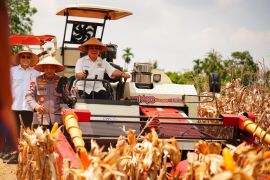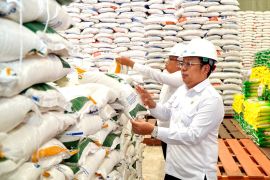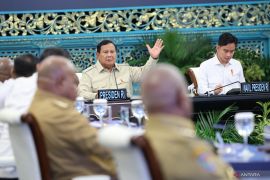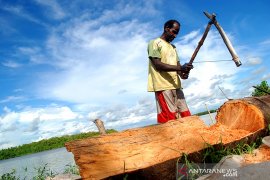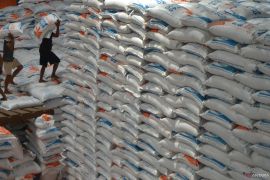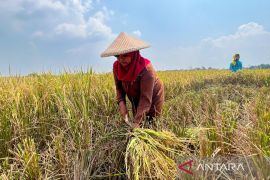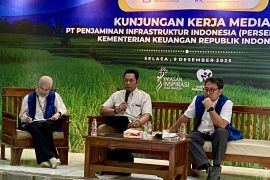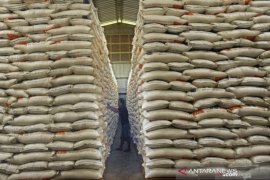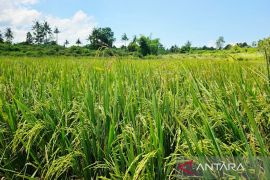President Prabowo Subianto has been promoting food self-sufficiency as a priority program to strengthen national sovereignty.
According to him, food sufficiency is the foundation of physical protection of the people. Without sufficient food, the state cannot guarantee the sustainability of its citizens' lives.
As a country blessed with vast land and oceans, Indonesia must manage its abundant natural resources to achieve food self-sufficiency.
Such efforts must also involve the community as well as prioritize environmental sustainability and preservation.
Recently, Forestry Minister Raja Juli Antoni revealed the government's plan to utilize 20 million hectares of reserved forests as sources of food, energy, and water security.
While underlining that the plan cannot be considered deforestation, the government has vowed to carry out the food self-sufficiency program while protecting forests.
One of the main focuses of reserved forest use is the cultivation of upland rice, which can grow in dry-land environments.
An estimated 1.1 million hectares of land can potentially produce up to 3.5 million tons of rice per year, Antoni highlighted.
This is equivalent to Indonesia's total rice imports in 2023, he pointed out.
In addition, the government plans to plant sugar palm trees as sources of bioethanol.
One hectare of land under sugar palm can produce 24 thousand kiloliters of bioethanol.
Meanwhile, 1.5 million hectares of land under sugar palm can produce 24 million kiloliters of bioethanol, which can replace 26 million kiloliters of fuel imports, he informed.
According to Antoni, the utilization of reserved forests is expected to support national food security by expanding food estates to the village level.
The Ministry of Forestry has a strategic role in providing land for the food self-sufficiency program.
Professor of forestry policy at the Faculty of Forestry and Environment, Bogor Agricultural University (IPB) Dodik Ridho Nurrochmat said that the government must pay attention to environmental sustainability when using forests as food reserves and expanding oil palm land.
According to him, the utilization of forests as food reserves must go hand in hand with environmental sustainability through land intensification to increase productivity, downstreaming to increase the added value of products, and extensification of agricultural land to increase production.
Furthermore, the extensification of oil palm plantations and food reserves does not always result in deforestation or trigger environmental damage if carried out with good planning and the right strategy.
It also does not cause deforestation if carried out in non-forested forest areas or other use areas (APL), he noted, based on the results of an evaluation of the 2024 National Forestry Plan (RKTN). This is because not all forest areas are physically forested, he explained.
There are 29 million hectares of non-forested forest areas, scattered across different locations and with diverse field conditions. Among the non-forested forest areas, there are settlements, gardens, rice fields, or abandoned and degraded land.
Abandoned land in forest areas should not be left unmanaged because it could become a source of conflict that threatens social, economic, and environmental stability.
In production forest areas, Nurrochmat said, degraded land must be immediately rehabilitated with trees and commercial plants, including oil palm and food crops, with a certain agroforestry pattern through a multi-forestry business scheme.
This would ensure that forest productivity increases and the area under forest cover also expands.
This means that planting oil palm and food crops with an agroforestry pattern in degraded production forest areas has the potential to bring about reforestation, not forest conversion or deforestation.
He also emphasized the need to rehabilitate degraded land in protected and conservation forest areas without changing the main function of the areas.
Meanwhile, economist and public policy expert from the National Development University "Veteran" Jakarta (UPNVJ), Achmad Nur Hidayat, said that the use of 20 million hectares of forests identified by the Forestry Ministry as food reserves will require an in-depth study of forest ecosystem sustainability.
If the forests have protected status, then converting them for food and other needs can threaten the sustainability of the ecosystem, he expounded.
He emphasized the significant role of protected forests as the guardians of environmental balance, oxygen providers, water regulators, and high biodiversity habitats.
Converting forests for intensive agriculture also often damages soil structure, reduces its fertility, and increases the risk of erosion, especially in hilly or steep sloping areas, he warned.
Hidayat further said that the utilization of forests for food production often opens up opportunities for massive expansion by large companies that can displace local and indigenous communities.
This can trigger social conflict and lead to the rights of indigenous communities, who often depend on forests for their livelihoods, getting ignored.
Therefore, according to him, it is necessary to think about how the use of forests as food reserves can follow the principle of sustainability, while shielding protected forests and conservation forests from changes in function.
If there is forest land that is damaged or degraded, the first step is to carry out rehabilitation to restore its function.
Changing the function of protected or conservation forests to food, energy, or water land is not a sustainable solution, he noted.
Exercising caution
The government is encouraging agricultural intensification on existing land by utilizing modern technology, increasing the efficiency of land use, and empowering farmers through education and training, so that harvests can be increased, without the need to open new land.
If production forests are used as food reserves, their management must be carried out with strict supervision.
Forest management permit holders need to be audited regularly to ensure that there is no misuse of land, especially in an era close to protected forests.
Strict sanctions also need to be applied for violations, including the issuance of management permits to irresponsible companies.
Another consideration for converting production forests into food reserves is the use of the agroforestry approach.
The approach involves integrating food crops with trees in one area, so that efforts to enable food production can run without eliminating the ecological function of the forest, such as carbon absorption, soil conservation, and biodiversity conservation.
A thorough assessment of land conditions, potential environmental impacts, and management capacity must be carried out before deciding on using the approach.
Instead of replacing forest functions, non-timber forest products, such as honey, sap, fruits, and herbal medicines, can be developed since the sustainable management of non-timber forest products can support food security without damaging the ecological function of the forest.
Critical or degraded land outside forest areas can be rehabilitated and turned into productive agricultural land. This approach is more environmentally friendly than changing forest functions.
In addition, modern agricultural technology, such as vertical farming, hydroponics, and aquaponics, can be a solution to increase food production without requiring land expansion.
With various proposals and recommendations, it is hoped that the food self-sufficiency program can run well in Indonesia, while prioritizing the principles of sustainability and benefits for the Indonesian people.
Related news: Indonesia seeks government-university synergy for forest protection
Related news: Indonesia, Norway to strengthen cooperation in forest protection
Editor: Rahmad Nasution
Copyright © ANTARA 2025

